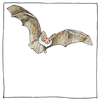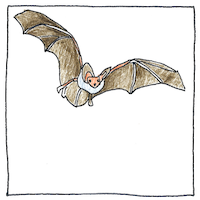Donald Griffin, Robert Galambos
acoustics

|
Bat echolocation
Lazzaro Spallanzani showed that bats can navigate in the dark. Charles Jurine showed that they use their heads and respond to sounds that we cannot hear. Finally, Griffin and Galambos showed that bats emit ultrasound and that they map their surroundings by listening to the echos.
Escalation
A bat constructs a mental 3-D map giving the location and path of a tiger moth in the night sky. The tiger moth produces a series of ultrasonic clicks specifically to jam the bat’s ability to locate it.
Bats do it
Bats do it; birds do it; and most people can’t do it. Eagles see their prey from high in the sky. Pigeons feel magnetic direction as they fly. Dogs hear higher frequencies. Mantis shrimp have sixteen color reception cones, where we have only three. Snakes see in the dark with infrared vision. Bears smell their meals from eighteen miles away. Sharks see electric fields that living things create. Yet we feel somehow superior, somehow bigger stronger smarter more able and somewhat more knowing, I don’t know why.



Assuming that one’s senses shape one’s experience, a bat with both eyes and echolocation, a goat with its rectangular pupils, a spider with its eight eyes, a butterfly with its compound eyes, and a scallop with a hundred little bright blue eyes experience the world differently than the way we do. Further, different combinations of sensory inputs matter. A spider’s eyesight is not very acute, but it can rely on touch, vibration, and taste as well as on its vision.
See also in The book of science:
Readings in wikipedia: